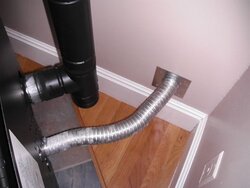I am CONFLICTED concerning OAK (Outside air kit/Outside Combustion Air etc) - here is my problem
The science behind why an OAK is a good idea makes perfect sense to me. I have recommended it to many on here, especially when they have depressurisation issues on a basement install - I wish that my old stove in our previous house had one installed - I likely would not have filled the house with smoke when the flue reversed one cold day. It essentially removes the firebox from the effects of depressurisation,
EXCEPT
The science behind why an OAK can be a problem makes sense also - see
http://www.woodheat.org/outdoorair/outdoorair.htm for the details . The Woodheat site is the main source of info on the negative side of OAK installs - his main point is that wind effect can generate enough negative pressure on the downwind side of a house to overcome the draft of some flues when operating EPA stoves.
So who is "he"? John Gulland is a well respected authority on wood heat issues, and was a big force behind having mandatory OAK removed from the National Building Code in Canada. His concerns surround pressure issues and wind effect creating the POTENTIAL to overwhelm flue draft and reverse the flue. Here is his Hearth.com wiki
https://www.hearth.com/econtent/index.php/wiki/John_Gulland/ . Some addition comments on the issue of OAK from Mr Gulland can be found here :
Yahoo Groups - Woodheat - OAK discussion. It is a good read - even those who are very pro OAK should review it, as you need to be able to address the concerns he raises in a logical fashion to counter them if you think they are wrong. For now, I just don't know. I am not a scientist nor engineer.
So, in the end, I am inclined to not install an OAK on my stove, as I don't have draft issues when cold, nor do I have drafts in my house that are aggrevated by indoor air being vented out my flue. Given that the loss of air from within the envelop of a house as a result of burning an EPA stove is REALLY LOW (in the order of 10-50 CFM, depending on your source - which is less than your bath fan), I am likely to spend my skills and money on other ways of keeping heat in my house/keeping outside air out of my house, like a block off plate (still not done that yet).
If I did have issues that an OAK can relieve, like spillage or cold hearth syndrome or flue reversal, then I would truly look at installing one, but I would have to re-read the issues John raises, and consider how to avoid the wind effect issues he raises.
I have not read any folks who installed an OAK who didn't say it worked well, but I haven't read much from folks who spend time and money on solutions who anectodatlly report that they wasted thier time and money. That said, I haven't read of any of the disasters that John predicts actually occuring (I haven't read everything mind you), so to me, I am still conflicted.
Like any tool, I think that an OAK is good at some things, and can have some issues - but burning wood has issues too, and I do that.
If anyone has read anything on actual OAK malfucntions, I would love to know.




